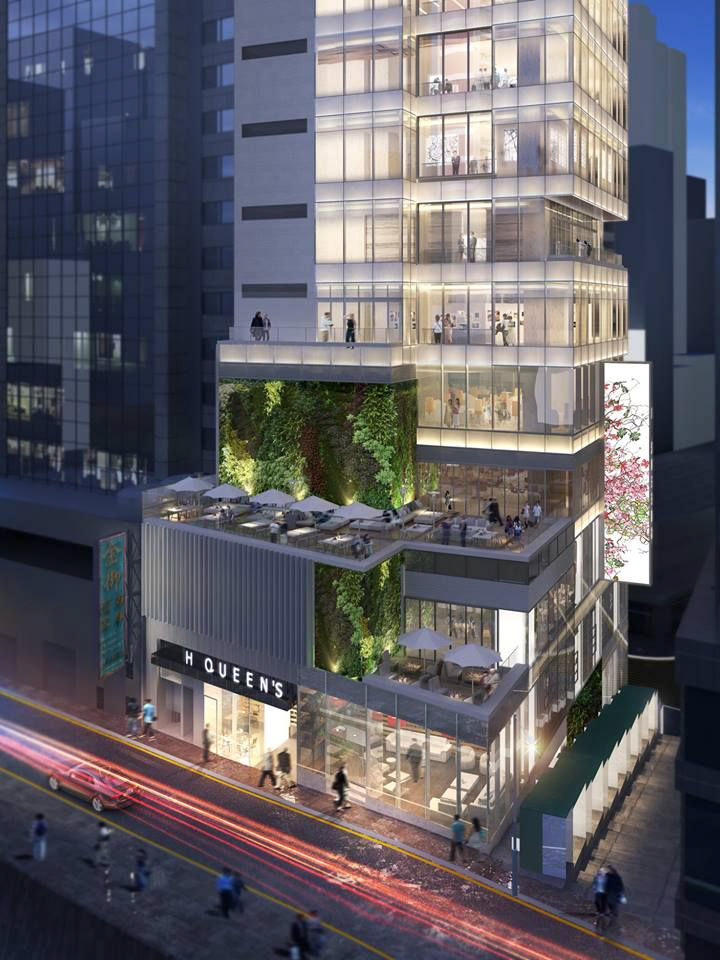The room is bare, stripped down to white walls and a grey concrete floor. Twenty-three storeys above ground, its purpose is to showcase the layout of the building’s units and distinctive design elements.
And there are quite a few of those, says Kristine Li of H Queen’s, a striking new glass tower on Queen’s Road Central designed specifically for art galleries and a handful of high-end dining and lifestyle options. This is truly unlike anywhere you’ve been before—the first vertical art space of its kind in Hong Kong, and one of the first in the world.
And Kristine, the eldest grandchild of property tycoon Lee Shau-kee, should know. H Queen’s, which has only just opened, is her baby, a project she personally launched and has led as deputy general manager of the portfolio leasing department of her family’s company, Henderson Land Development, the real estate giant behind H Queen’s.
I’ve always enjoyed art but never worked on a property solely dedicated to it, says Kristine. It was challenging but also a great learning curve. This is such an innovative concept, particularly in the space context of Hong Kong. The city is so dense. To have created an upward art hub, it is quite remarkable.
Watch: The Harbour Arts Sculpture Park injects world-class art into Hong Kong’s harbourfront

A game changer
H Queen’s is indeed a game changer for the city’s creative scene. Among its tenants are some of the world’s most important international galleries, such as Hauser & Wirth, Gagosian, David Zwirner, and Pace. These are powerhouses of the art world; their moving in boosts both Hong Kong’s artistic credibility and the property’s prestige in real estate terms.
Raising the bar
Architecturally, too, the 24-storey structure is a new benchmark. Its energy-efficient triple glazing enables better regulation of the indoor climate, and the operable curtain-wall facade, in which some windows are able to be opened, screens out damaging ultra-violet rays.
The lighting indoors and on the outdoor signboards comes from computer-controlled LED units, a range of green fixtures give each area an airy, open feel, and a sleek glass lift takes visitors up and down the first 10 floors. And then there are those design elements Kristine alluded to.

High ceilings, huge windows that allow passers-by to peek inside the galleries from the street, a space layout conceived specifically for exhibitions, and a heavy load-bearing floor that can support large pieces of artwork, she explains. Though perhaps the most remarkable aspect is the gondola system. I think we really pushed the envelope with that.
She is referring to the operable facade incorporated by the architect, William Lim of the firm CL3, which allows large and heavy objects to be lifted from the ground and delivered to the desired floor through sliding windows measuring 3.65m x 4.65m on each gallery level.
It’s another first, says Kristine, a whole new approach to art logistics and delivery. We spent a lot of time thinking about what galleries need and how to create the best space for them. Each aspect of the building reflects that.
See more: Take a tour of gallerist Katie de Tilly’s art-filled Sai Kung abode

The tenant mix
Unsurprisingly, finding tenants wasn’t difficult. Once we went out and started explaining our vision for H Queen’s to the galleries, the interest was immediate.
Having top galleries was always the plan, but Kristine and her team also worked hard to ensure the building housed a good mix of European, American and Asian names, such as the aforementioned David Zwirner from New York, Hong Kong’s Pearl Lam Galleries, South Korean auction house Seoul Auction, Bangkok’s Tang Contemporary Art and London’s Whitestone Gallery. We wanted a comprehensive representation of art from around the world to make the property even more unique.
As well as the art spaces, H Queen’s houses five restaurants, a cake shop, and a handful of indie boutiques. We envisioned this to be a place for the creative community to come and play, Kristine says, to see world-famous exhibitions all year around and enjoy top-notch amenities. Art has become such an important cultural component of people’s lives and dialogues in Hong Kong. H Queen’s wants to be part of that dialogue.

Public art displays
This is why the Henderson Land Development team behind H Queen’s has also spearheaded various displays of public art in the two years leading up to its opening last December. Time & Scale, a show organised by the developer during Art Basel in 2016, saw 10 Hong Kong artists transform the hoardings around the H Queen’s construction site with their art. Last year, the digital art project Voyages followed, showcasing works from outstanding multimedia artists such as teamLab represented by some of the building’s future tenants.
This year, H Queen’s is the lead sponsor of the Harbour Arts Sculpture Park, a temporary project that runs until April 11 featuring sculptures by 19 emerging and established local and international contemporary artists. We’ve asked some of the galleries to lend pieces from their collections, and sponsored one Hong Kong artist, Kacey Wong, says Kristine.
We see H Queen’s as an opportunity to propel the art scene forward, but also to push more exchanges—between the public and the artists, between local and international galleries, Kristine says. It’s not just a building.
This story was originally published on our sister site, Hong Kong Tatler.
The post Kristine Li Takes Us Through H Queen’s, Hong Kong’s First Vertical Art Space appeared first on Home Journal.






